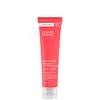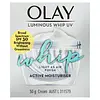What's inside
What's inside
 Key Ingredients
Key Ingredients

 Benefits
Benefits

 Concerns
Concerns

 Ingredients Side-by-side
Ingredients Side-by-side

Water
Skin ConditioningC12-15 Alkyl Benzoate
AntimicrobialZinc Oxide
Cosmetic ColorantTitanium Dioxide
Cosmetic ColorantGlycerin
HumectantIsononyl Isononanoate
EmollientButylene Glycol
HumectantCetearyl Alcohol
EmollientPotassium Cetyl Phosphate
EmulsifyingDimethicone
EmollientGlyceryl Stearate
EmollientGlycyrrhiza Glabra Root Extract
BleachingActinidia Chinensis Fruit Extract
EmollientArgania Spinosa Kernel Oil
EmollientTetrapeptide-30
Skin ConditioningLinoleic Acid
CleansingResveratrol
AntioxidantAscorbyl Glucoside
AntioxidantNiacinamide
SmoothingTocopheryl Acetate
AntioxidantMagnesium Ascorbyl Phosphate
AntioxidantBisabolol
MaskingTocopherol
AntioxidantPhospholipids
Skin ConditioningLecithin
EmollientGlycine Soja Sterols
EmollientXanthophylls
Skin ConditioningPullulan
Sodium Gluconate
Skin ConditioningXanthan Gum
EmulsifyingSclerotium Gum
Emulsion StabilisingAlumina
AbrasiveCaprylic/Capric Triglyceride
MaskingCitric Acid
BufferingTriethoxycaprylylsilane
C13-14 Isoparaffin
EmollientAcrylates Copolymer
Polyhydroxystearic Acid
EmulsifyingCaprylyl Glycol
EmollientPolyacrylamide
Ceteareth-20
CleansingAluminum Stearate
Cosmetic ColorantLaureth-7
EmulsifyingEthylhexylglycerin
Skin ConditioningPhenoxyethanol
PreservativeWater, C12-15 Alkyl Benzoate, Zinc Oxide, Titanium Dioxide, Glycerin, Isononyl Isononanoate, Butylene Glycol, Cetearyl Alcohol, Potassium Cetyl Phosphate, Dimethicone, Glyceryl Stearate, Glycyrrhiza Glabra Root Extract, Actinidia Chinensis Fruit Extract, Argania Spinosa Kernel Oil, Tetrapeptide-30, Linoleic Acid, Resveratrol, Ascorbyl Glucoside, Niacinamide, Tocopheryl Acetate, Magnesium Ascorbyl Phosphate, Bisabolol, Tocopherol, Phospholipids, Lecithin, Glycine Soja Sterols, Xanthophylls, Pullulan, Sodium Gluconate, Xanthan Gum, Sclerotium Gum, Alumina, Caprylic/Capric Triglyceride, Citric Acid, Triethoxycaprylylsilane, C13-14 Isoparaffin, Acrylates Copolymer, Polyhydroxystearic Acid, Caprylyl Glycol, Polyacrylamide, Ceteareth-20, Aluminum Stearate, Laureth-7, Ethylhexylglycerin, Phenoxyethanol
Water
Skin ConditioningVinyl Dimethicone/Methicone Silsesquioxane Crosspolymer
Glycerin
HumectantNiacinamide
SmoothingIsohexadecane
EmollientIsopropyl Isostearate
EmollientPanthenol
Skin ConditioningCamellia Sinensis Leaf Extract
AntimicrobialZinc Gluconate
Skin ConditioningMagnesium Aspartate
Skin ConditioningCopper Gluconate
Skin ConditioningBHT
AntioxidantInositol
HumectantDimethicone
EmollientCaprylyl Glycol
EmollientDimethiconol
EmollientCetearyl Glucoside
EmulsifyingCetearyl Alcohol
EmollientStearic Acid
CleansingPalmitic Acid
EmollientStearyl Alcohol
EmollientCetyl Alcohol
EmollientBehenyl Alcohol
EmollientArachidyl Alcohol
EmollientDisodium EDTA
PEG-100 Stearate
Sodium Polyacrylate Starch
Absorbent1,2-Hexanediol
Skin ConditioningPhenoxyethanol
PreservativeBenzyl Alcohol
PerfumingMethylparaben
PreservativeParfum
MaskingHexyl Cinnamal
PerfumingLinalool
PerfumingHydroxycitronellal
PerfumingAlpha-Isomethyl Ionone
PerfumingCaramel
Cosmetic ColorantWater, Vinyl Dimethicone/Methicone Silsesquioxane Crosspolymer, Glycerin, Niacinamide, Isohexadecane, Isopropyl Isostearate, Panthenol, Camellia Sinensis Leaf Extract, Zinc Gluconate, Magnesium Aspartate, Copper Gluconate, BHT, Inositol, Dimethicone, Caprylyl Glycol, Dimethiconol, Cetearyl Glucoside, Cetearyl Alcohol, Stearic Acid, Palmitic Acid, Stearyl Alcohol, Cetyl Alcohol, Behenyl Alcohol, Arachidyl Alcohol, Disodium EDTA, PEG-100 Stearate, Sodium Polyacrylate Starch, 1,2-Hexanediol, Phenoxyethanol, Benzyl Alcohol, Methylparaben, Parfum, Hexyl Cinnamal, Linalool, Hydroxycitronellal, Alpha-Isomethyl Ionone, Caramel
 Reviews
Reviews

Ingredients Explained
These ingredients are found in both products.
Ingredients higher up in an ingredient list are typically present in a larger amount.
Caprylyl Glycol is a humectant and emollient, meaning it attracts and preserves moisture.
It is a common ingredient in many products, especially those designed to hydrate skin. The primary benefits are retaining moisture, skin softening, and promoting a healthy skin barrier.
Though Caprylyl Glycol is an alcohol derived from fatty acids, it is not the kind that can dry out skin.
This ingredient is also used as a preservative to extend the life of products. It has slight antimicrobial properties.
Learn more about Caprylyl GlycolCetearyl alcohol is a mixture of two fatty alcohols: cetyl alcohol and stearyl alcohol. It is mainly used as an emulsifier. Emulsifiers help prevent the separation of oils and products. Due to its composition, it can also be used to thicken a product or help create foam.
Cetearyl alcohol is an emollient. Emollients help soothe and hydrate the skin by trapping moisture.
Studies show Cetearyl alcohol is non-toxic and non-irritating. The FDA allows products labeled "alcohol-free" to have fatty alcohols.
This ingredient is usually derived from plant oils such as palm, vegetable, or coconut oils. There is debate on whether this ingredient will cause acne.
Due to the fatty acid base, this ingredient may not be Malassezia folliculitis safe.
Learn more about Cetearyl AlcoholDimethicone is a type of synthetic silicone created from natural materials such as quartz.
What it does:
Dimethicone comes in different viscosities:
Depending on the viscosity, dimethicone has different properties.
Ingredients lists don't always show which type is used, so we recommend reaching out to the brand if you have questions about the viscosity.
This ingredient is unlikely to cause irritation because it does not get absorbed into skin. However, people with silicone allergies should be careful about using this ingredient.
Note: Dimethicone may contribute to pilling. This is because it is not oil or water soluble, so pilling may occur when layered with products. When mixed with heavy oils in a formula, the outcome is also quite greasy.
Learn more about DimethiconeGlycerin is already naturally found in your skin. It helps moisturize and protect your skin.
A study from 2016 found glycerin to be more effective as a humectant than AHAs and hyaluronic acid.
As a humectant, it helps the skin stay hydrated by pulling moisture to your skin. The low molecular weight of glycerin allows it to pull moisture into the deeper layers of your skin.
Hydrated skin improves your skin barrier; Your skin barrier helps protect against irritants and bacteria.
Glycerin has also been found to have antimicrobial and antiviral properties. Due to these properties, glycerin is often used in wound and burn treatments.
In cosmetics, glycerin is usually derived from plants such as soybean or palm. However, it can also be sourced from animals, such as tallow or animal fat.
This ingredient is organic, colorless, odorless, and non-toxic.
Glycerin is the name for this ingredient in American English. British English uses Glycerol/Glycerine.
Learn more about GlycerinNiacinamide is a multitasking form of vitamin B3 that strengthens the skin barrier, reduces pores and dark spots, regulates oil, and improves signs of aging.
And the best part? It's gentle and well-tolerated by most skin types, including sensitive and reactive skin.
You might have heard of "niacin flush", or the reddening of skin that causes itchiness. Niacinamide has not been found to cause this.
In very rare cases, some individuals may not be able to tolerate niacinamide at all or experience an allergic reaction to it.
If you are experiencing flaking, irritation, and dryness with this ingredient, be sure to double check all your products as this ingredient can be found in all categories of skincare.
When incorporating niacinamide into your routine, look out for concentration amounts. Typically, 5% niacinamide provides benefits such as fading dark spots. However, if you have sensitive skin, it is better to begin with a smaller concentration.
When you apply niacinamide to your skin, your body converts it into nicotinamide adenine dinucleotide (NAD). NAD is an essential coenzyme that is already found in your cells as "fuel" and powers countless biological processes.
In your skin, NAD helps repair cell damage, produce new healthy cells, support collagen production, strengthen the skin barrier, and fight environmental stressors (like UV and pollution).
Our natural NAD levels start to decline with age, leading to slower skin repair, visible aging, and a weaker skin barrier. By providing your skin niacinamide, you're recharging your skin's NAD levels. This leads to stronger, healthier, and younger looking skin.
Another name for vitamin B3 is nicotinamide. This vitamin is water-soluble and our bodies don't store it. We obtain Vitamin B3 from either food or skincare. Meat, fish, wheat, yeast, and leafy greens contain vitamin B3.
The type of niacinamide used in skincare is synthetically created.
Learn more about NiacinamidePhenoxyethanol is a preservative that has germicide, antimicrobial, and aromatic properties. Studies show that phenoxyethanol can prevent microbial growth. By itself, it has a scent that is similar to that of a rose.
It's often used in formulations along with Caprylyl Glycol to preserve the shelf life of products.
Water. It's the most common cosmetic ingredient of all. You'll usually see it at the top of ingredient lists, meaning that it makes up the largest part of the product.
So why is it so popular? Water most often acts as a solvent - this means that it helps dissolve other ingredients into the formulation.
You'll also recognize water as that liquid we all need to stay alive. If you see this, drink a glass of water. Stay hydrated!
Learn more about Water